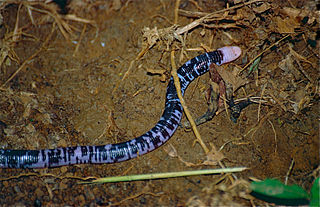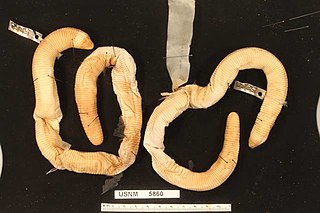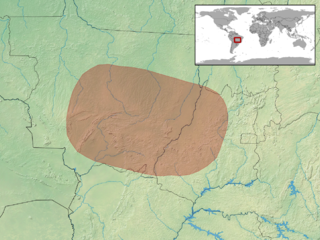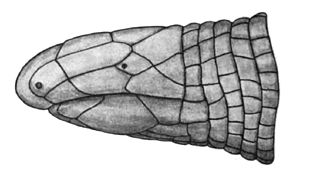
Amphisbaenia is a group of usually legless squamates, comprising over 200 extant species. Amphisbaenians are characterized by their long bodies, the reduction or loss of the limbs, and rudimentary eyes. As many species have a pink body and scales arranged in rings, they have a superficial resemblance to earthworms. While the genus Bipes retains forelimbs, all other genera are limbless. Although superficially similar to the snakes and blind lizards, recent phylogenetic studies suggest that they are most closely related to wall lizards of the family Lacertidae. Amphisbaenians are widely distributed, occurring in North America, Europe, Africa, South America, Western Asia and the Caribbean. Most species are less than 6 inches (15 cm) long.
Arda or ARDA may refer to:

Amphisbaena caeca, commonly known as the Puerto Rican worm lizard or blind worm lizard, is a species of worm lizard endemic to Puerto Rico. These animals are vermicular reptiles that live under logs, rocks, and dirt. Other species of Amphisbaenids in the Caribbean include Amphisbaena bakeri, Amphisbaena fenestrata, Amphisbaena schmidti, Amphisbaena xera, and Cadea blanoides.

Amphisbaena fuliginosa, also known as the black-and-white worm lizard, speckled worm lizard or spotted worm lizard, is a species of amphisbaenian in the genus Amphisbaena. The ecology of A. fuliginosa is poorly known due to its fossorial habits. However, this species can be easily distinguished from others because of its characteristic white and black mosaic pattern that covers both the dorsal and ventral side.

The Iberian worm lizard, Mediterranean worm lizard, or European worm lizard is a species of reptile in the family Blanidae of the clade Amphisbaenia. The Iberian worm lizard is locally known as cobra-cega (Portuguese), culebrilla ciega (Spanish), and colobreta cega (Catalan), all meaning "blind snake". Recent studies into the mitochondrial and nuclear genomic data of 47 isolated B. cinereus populations show rather large sequence divergence between two apparent clades, leading some researchers to call for a division of the Iberian worm lizard into two species. While little is known of B. cinereus in comparison with some other reptile species, new insight is growing about this primitive, ancestral reptile.

Amphisbaena is a genus in the family Amphisbaenidae, commonly known as worm lizards. Over 100 species are placed in this diverse genus.

The crooked worm lizard is a worm lizard species in the genus Amphisbaena.

The neglected worm lizard is a worm lizard species in the genus Amphisbaena. It is endemic to Brazil.
Cope's worm lizard is a worm lizard species in the genus Amphisbaena.

Amphisbaena schmidti, known commonly as Schmidt's worm lizard or the Puerto Rican dusky worm lizard, is a species of amphisbaenian in the family Amphisbaenidae. The species is endemic to the Caribbean.
The spotted amphisbaena is a species of amphisbaenian in the family Cadeidae. This species is endemic to the island of Cuba.

Mary Cynthia Dickerson (1866–1923) was an American herpetologist and the first curator of herpetology at the American Museum of Natural History, as well as the first curator in the now defunct department of Woods and Forestry. For ten years she was the editor of The American Museum Journal, which was renamed Natural History during her editorship. She published two books: Moths and Butterflies (1901) and The Frog Book (1906) as well as numerous popular and scientific articles. She described over 20 species of reptiles and is commemorated in the scientific names of four lizards.

Cadea palirostrata, also known as Dickerson's worm lizard or the Cuban sharp-nosed amphisbaena, is a species of amphisbaenian in the family Cadeidae, described by herpetologist Mary Cynthia Dickerson in 1913. This species is endemic to Isla de la Juventud, an island of western Cuba.
Loveridgea is a genus of amphisbaenians in the family Amphisbaenidae. Species in the genus are commonly known as worm lizards, even though they are not lizards. Two species are placed in this genus.
The Cuban many-ringed amphisbaena, also known commonly as the Cuban many-ringed worm lizard, is a species of amphisbaenian in the family Amphisbaenidae. The species is endemic to Cuba.
The Cuban pink amphisbaena is a species of worm lizard in the family Amphisbaenidae. The species is endemic to Cuba.
The Cuban worm lizard is a worm lizard species in the family Amphisbaenidae. It is endemic to Cuba.
Amphisbaena roberti is a species of worm lizard in the family Amphisbaenidae. The species is endemic to South America.









